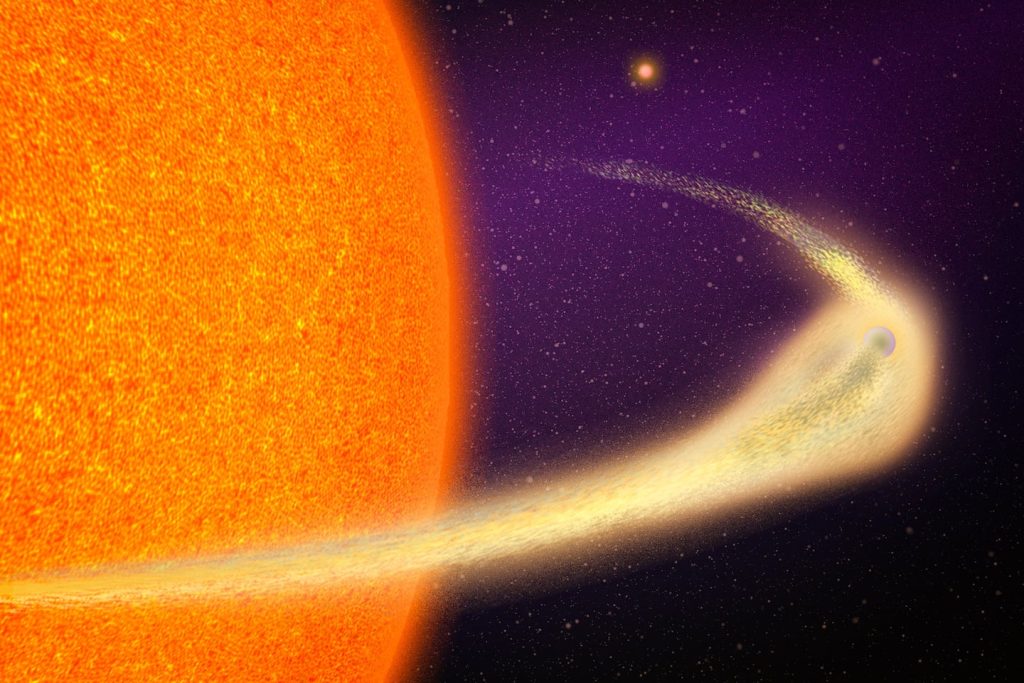TESS, launched in 2018, is the first telescope to scan the entire sky for planets by shifting its field-of-view every month.
The disintegrating planet, named BD+05 4868 Ab, is one of just four planets of its kind that scientists have discovered.
Astronomers said the cause of BD+05 4868 Ab’s rapid disintegration is its proximity to its star — 50 times closer than Earth is to the sun — and its relatively small size.
“The planet got so close to its star that the heat started evaporating its surface,“ said Avi Shporer, a collaborator on the discovery and a research scientist at the MIT Kavli Institute for Astrophysics and Space Research, in a phone interview Thursday. “The planet is not big enough to hold onto that material with its gravity.”
The planet is about 3,000 degrees Fahrenheit and is covered in magma that is boiling off into space, leaving a comet-like trail of debris, the astronomers said.
This comet-like tail causes an unusual blocking of the light emitted from the planet’s star, which researchers first observed in August 2022 and again in August 2024, the astronomers explained.
When exoplanets pass in front of their stars, astronomers observe a dip in the total amount of light received from that star, called a transit.
Dips in starlight are usually brief and regular, but in the case of BD+05 4868 Ab, a dip in light lingered longer than expected.
“The dimming pattern we observed was as if a comet passed in front of the star,” said Marc Hon, a postdoctoral researcher also at the Kavli Institute for Astrophysics and Space Research, in the Thursday interview alongside Shporer.
This strange observation puzzled Hon, who decided to flag the data set so others on the team could take a look.
“Marc wasn’t looking specifically for this kind of object, … but he was bright enough to understand that it was scientifically interesting,” Shporer said.
The tail of debris stretches up to 9 million kilometers long — half of the planet’s entire orbit — according to astronomers.
The discovery of BD+05 4868 Ab could lead to a host of other discoveries, expanding our understanding of rocky exoplanets as a whole, astronomers said.
The TESS team submitted a proposal for the James Webb Space Telescope to observe BD+05 4868 Ab’s system. It has been approved and is scheduled for observation in October, the astronomers said.
The goal for the Webb telescope’s period of observation is to determine the mineral composition of BD+05 4868 Ab’s inner layers, made possible because of the planet’s disintegrating nature.
By identifying which colors in the infrared are absorbed as light passes through the dust tail, scientists can identify the type of mineral species present from the planet.
“It’s going to be as if we went to that planet and drilled inside,” Shporer said. “It is one of the only ways possible to have this kind of direct measurement of the internal composition of an exoplanet compared to our theoretical models.”
“Then, we will be able to test the theories we have of far-away planets,” Shporer added.
After determining the mineral makeup of BD+05 4868 Ab, scientists hope to gain a better understanding of the potential habitability of planets beyond our solar system, Hon said.
“We’ve gained an appetite for this now,” Hon said of their discovery. “We are now starting to be a lot more cognizant of weird events like this. … Now, the team is going back through the data and looking for other interesting things we might have missed.”
Sarah Mesdjian can be reached at sarah.mesdjian@globe.com. Follow her on X @sarahs_journal.

